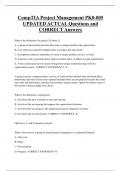CompTIA Project Management PK0-005
UPDATED ACTUAL Questions and
CORRECT Answers
What is the definition of a project? (Choose 2)
A. A group of interrelated activities that create a unique benefit to the organization
B. A set of process repeated multiple times to produce the same result
C. A temporary endeavor undertaken to create a unique product, service, or result
D. A process used to generate profit, improve market share, or adhere to legal requirements
E. A time-constrained activity used to bring about unique results that align with the
organization's goals - CORRECT ANSWER✔✔- C, E
A project creates a unique product, service, or result and has defined start and finish dates.
Interrelated activities or processes repeated multiple times are not projects because they don't
have start and finish dates, and they don't produce unique results. Option D outlines some of
the reasons a project might come about.
What is the definition of operations?
A. Activities that have a definitive start and end date
B. Activities that are ongoing that support the organization's business
C. Activities that are unique to the organization and are temporary in nature
D. Activities that are time bound - CORRECT ANSWER✔✔- B
Options A, C, and D describe a project.
What is the term for a group of related projects managed in a coordinated fashion?
A. Life cycle
B. Phase
C. Process group
D. Program - CORRECT ANSWER✔✔- D
,A program is a group of related projects that can benefit from coordinated project
management. Life cycles are the various stages a project goes through, and process groups
consist of Discovery/Concept, Initiating, Planning, Executing, and Closing
Which of the following are true regarding project portfolios? (Choose two)
A. The independent projects in the portfolio may not have anything in common
B. The programs in the portfolio are related to one another
C. The programs and projects within the portfolio support the strategic goals of the portfolio
D. An organization has only one portfolio
E. Portfolios consist of programs and do not contain stand-alone projects - CORRECT
ANSWER✔✔- A, C
Portfolios consist of programs, subportfolios, and independent projects that are not
necessarily related to one another. An organization could have any number of portfolios.
Which of the following make up the life cycle phases according to the CompTIA exam
objectives?
A. Initiating, Planning, Executing, Closing
B. Discovery/Concept, Initiating, Planning, Executing, Closing
C. Discovery/Concept, Planning, Executing, Monitoring and Controlling, Closing
D. Initiating, Planning, Executing, Monitoring and Controlling, Closing - CORRECT
ANSWER✔✔- B
The life cycle phases of project management according to CompTIA are Discovery/Concept,
Initiating, Planning, Executing, and Closing. The PMBOK Guide calls these process groups
and they are as follows: Initiating, Planning, Executing, Monitoring and Controlling, and
Closing
You receive a request from customer service to purchase and implement a customer
management system for the service-support staff. What type of need or demand does this
describe?
A. Organizational need
B. Market demand
,C. Legal requirement
D. Technological advance - CORRECT ANSWER✔✔- A
A request to develop a product for use by an internal department is an organizational need.
Market demands are driven by the needs of the market, legal requirements come about
because of rules or regulations that must be complied with, and technological advances come
about due to changes or advancements in technology. This question describes purchasing and
implementing a new system for the organization but doesn't imply the technology itself is
new or advanced
Your project stakeholder is working on the business case. They ask you for some assistance.
You suggest to them that the business case should include which of the following?
A. Feasibility study
B. Alignment to the strategic plan
C. Justification
D. Alternative solutions
E. All of the above - CORRECT ANSWER✔✔- E
The business case analysis may include the feasibility study but should always include the
justification for the project, alignment to the strategic plan, benefits and rewards (using
financial analysis), alternative solutions, and more.
Preexisting contracts, prequalified vendors, and project documents such as the scope
statement, schedule, risk log, and lessons learned are known as which of the following?
(Choose two)
A. Vestige
B. Relic
C. Historical information
D. Artifacts - CORRECT ANSWER✔✔- C, D
Artifacts, also known as historical information, include any documents, physical elements,
evidence, or information associated with past projects.
, Your project has expected cash inflows of $1.2 million in year 1, $2 million in year 2, and
$4.4 million in year 3, for a total of $7.6 million in today's dollars. Which technique was used
to determine this?
A. Discounted cash flow
B. IRR
C. NPV
D. Cost-benefit analysis - CORRECT ANSWER✔✔- A
The discounted cash flow technique compares the total value of each year's expected cash
inflow to today's dollar. IRR calculates the internal rate of return, NPV determines the net
present value, and cost-benefit analysis determines the cost of the project versus the benefits
received.
Your selection committee wants to compare the profitability of three projects against each
other to determine which should move forward. The projects do not have equal timelines.
You are using this formula:
(Current value or gain from the investment -- Cost of investment) / (Cost of the investment)
Which of the following are true regarding this question? (Choose two)
A. This is the formula for discounted cash flows
B. This is the formula for ROI
C. You'll need to annualize the returns since each project has a different time period
D. This is the formula for NPV
E. The returns are calculated by year and the total return for each project should be used for
comparison - CORRECT ANSWER✔✔- B, C
This is the formula for ROI. ROI does not take time periods into account, so you'll need to
annualize the returns for comparison purposes.
The idea behind most cash flow techniques is that money today is worth more than money in
the future. What is this known as?
A. Present value of money
B. Future value of money




